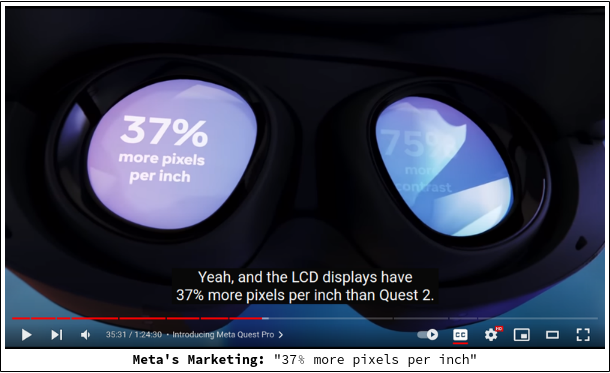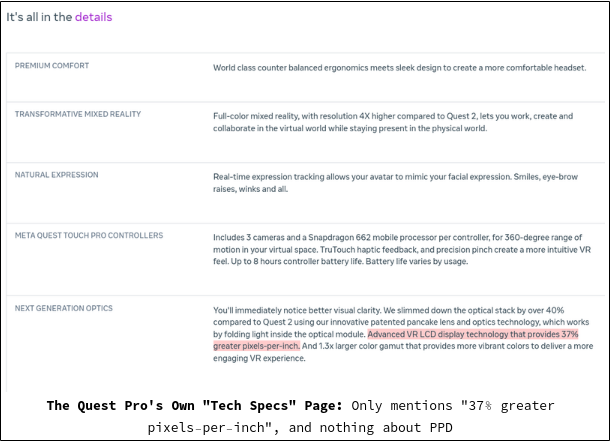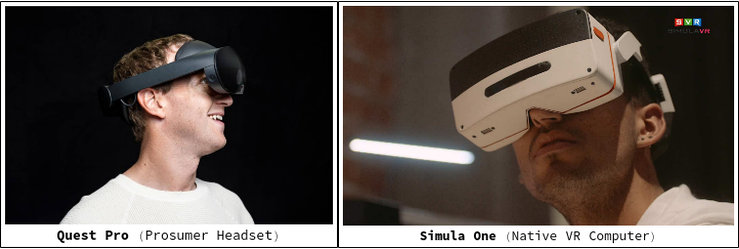
This post offers constructive criticism on Meta's product vision, and some pushback on what we feel is some misleading marketing.
1 Meta's Subpoena Has Been Dropped
First, regarding on our last update on Meta's unexpected subpoena of SimulaVR: we are pleased to report that Meta's legal team has completely dropped their subpoena against us. Overall, their legal team was generally pretty cordial with us, and we are happy they decided to relieve us of having to provide everything originally commanded. Moving forward, we can return to focusing 100% on engineering (and updates).
2 The Quest Pro's "37% PPI increase" claim is misleading: the Quest Pro's actual pixel density is only 10% better than the Quest 2
Perhaps it's just an honest mistake, but it's unclear to us why Meta has placed "37% higher PPI" throughout most of its Quest Pro marketing without specifying that its actual PPD increase is only 10%. We've seen lots of evidence (at least on Twitter) that people seem to be confusing a 37% PPI increase to a 37% visible pixel density increase.
Mark Zuckerberg also repeated this in his Meta Connect Keynote a week ago, without (as far as we can tell) ever mentioning anything about the Quest's actual visible pixel density. An exception to this trend is in a Meta blog post released on Oct 11th, which states:
Meta Quest Pro also has 37% more pixels per inch and 10% greater pixels per degree than Meta Quest 2, making everything from reading text to playing games look better.
A 10% pixel density improvement is of course better than nothing, and there are other cool things about the Quest Pro to praise, but the Quest Pro's pixel density is still basically at the same level as the Quest 2. Since Meta is marketing their device for productivity usage, and text readability is almost a direct function of visible pixel density, this seems like a pretty important detail to omit in the product's own "technical specs" page.
2.1 PPD is what matters in VR, not PPI
![]()
Though this is counter-intuitive, a 37% display PPI increase doesn't necessarily translate into a 37% visible pixel density increase. (In fact, it's actually even possible for a display PPI increase to translate into a visible pixel density decrease! We discussed this back in our March post How Simula's Optical Design Achieves its PPD, but to summarize:
- The components of a VR system which translate into visible pixel density are (i) how many total pixels are availble on the VR displays and (ii) how the optical system distributes those pixels across a given Field of View.
- Thus it's possible for (i) PPI to increase, (ii) display dimensions to shrink, yet (iii) the optical system is still unable to distribute a higher concentration of pixels to the user than under the original configuration.
- (A similar argument can show why display resolution is similarly misleading).
Thus, knowing that a VR display PPI has increased still leaves it indeterminate how the visible pixel density (and hence text clarity) of the overall system is impacted.
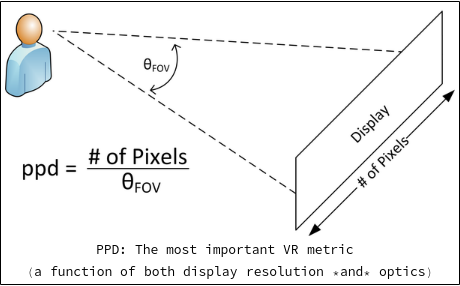
The best metric to use is VR Pixels-Per-Degree (PPD), which captures how a VR headset delivers visible pixel density to a user. This is why VR comparison pages like Wikipedia and vr-compare.com use PPD as their primary comparison metric instead of PPI.
3 Philosophical Differences: Simula One vs. Quest Pro
The Simula One offers native VR computing with high pixel density, while the Quest Pro offers WiFi-tethered monitor emulation with lower pixel density.
-
The Quest Pro cannot replace your laptop or PC. In fact the Quest actually needs a laptop or PC to WiFi tether into (for VR Desktop), so that it can emulate and stream a (limited number) of host monitors in VR space.
-
The Quest Pro limits the number of monitors you can stream to 5. The Quest Pro's WiFi tethering places latency & bandwidth constraints on the experience: you are only able to stream 5 screens max to the headset. This blocks basically the #1 selling point of VR productivity, which is "unlimited screens".
-
The quest Pro isn't reliably portable. On top of this, if your WiFi connection is spotty or simply unavailable, you don't even get to use the device's VR Desktop. This makes its use more limiting in coffee shops, airplanes, book stores, or anywhere you aren't already 100% confident there's not a spotty WiFi connection.
-
The Quest Pro's pixel density isn't realistically adequete for VR computing. As we mentioned above, the Quest Pro's pixel density is only 10% higher than the Quest 2's (bringing it to 22.69 PPD). This is not realistically good enough to support long sessions of reading text and other fine details in VR.
-
The Quest Pro offers no true window management. The Quest Pro is only able to emulate (a limited number of) monitors on a host machine. It has no awareness of the individual apps, and doesn't allow you to separate or combine them into your own unique views or workspaces.
We're not the only ones who are skeptical of Meta's attempt to market their headset as a productivity-focused one. From Meta Quest Pro – A High-End Consumer Headset Masquerading As Enterprise:
In my eyes, the Meta Quest Pro is absolutely a prosumer device, with it still very much being a consumer device that can also be used for some low-hanging business applications. I think that while Meta’s partnership with Microsoft does lend some credibility to its business focus with the Quest Pro, the company’s history and overall consumer focus makes it hard to believe long term. I believe that the Meta Quest Pro is a fantastic-looking and designed headset with many of the right features and capabilities to move the industry forward, but not as a business device. It is a high-end mixed reality device that sits in a high-end tier of the company’s consumer offerings. I don’t see this device replacing laptops...
4 Spec Comparison: Simula One vs. Quest Pro
4.1 Headset Specs
As mentioned above, the Simula One offers vastly superior pixel density than the Meta Quest Pro.[1]
| Simula One | Meta Quest Pro | |
 |  | |
| Price | $2,799 Preorder Price; $3,500 MSRP | $1,499 |
| Platform |  |  |
| Linux | Quest System Software | |
| Type of Headset | VR Computer (VRC) | "prosumer" headset (see above) |
| PPD | 35.5 | 22.6[2] |
| Resolution | 2448x2448 per eye | 1800x1920 per-eye |
| Refresh Rate | 90 Hz (throttleable to <75 Hz to save battery life, boostable to 120 Hz for better fidelity) | 90 Hz (throttleable down to 72 Hz to save battery life) |
| Field of View | 100° horizontal; 100° vertical | 106° horizontal; 96° diagonal |
| Passthrough Cameras | 2448x2048 RGB cameras | 1800 × 1920 RGB cameras |
| IPD Range | 55mm-77mm automatic adjustable[3] | 55-75 mm hardware adjustable |
[1] Meta provides hardly any detailed specs on their own technical specifications page. Most of these were gathered from VR Comparison and Meta's blog.
[2] Meta doesn't provide this basic stat on their own technical specifications page, but does state in a blog post that the Quest Pro has "10% greater pixels per degree than Meta Quest 2", which we extrapolate to infer a PPD of 1.1 * 20.58 = 22.638.
[3] We have an additional +/-2mm in additional IPD adjustment which might be achievable (for a potential range of 53mm-79mm).
4.2 Compute Specs
The Simula One has compute specs that are legitimately comparable to a premium office laptop. For example, it supports an x86 architecture (i.e. just like a premium laptop), instead of an ARM based architecture like the Quest Pro (an architecture which mostly runs on mobile phones and other portable devices, with the notable exception of MacBooks). Simula's speed, RAM, and storage are likewise significantly better than the Quest Pro.
| Simula One | Meta Quest Pro | |
 |  | |
| Price | $2,799 Preorder Price; $3,500 MSRP | $1,499 MSRP |
| Manufacturer | SimulaVR | Meta |
| Platform |  |  |
| Linux | Quest System Software | |
| Type of Headset | VR Computer (VRC) | "prosumer" headset (see above) |
| Speakers | ✗ | ✓ |
| Microphone | ✗ | ✓ |
| 3.5mm Audio Jack | ✓ | ✓ |
| Ports | 1 USB4/Thunderbolt 4; 3-4 USB3.2 Gen 2 via USB-C with DisplayPort alt mode | USB Type-C, charging contacts |
| Video Connection | DisplayPort 1.4a, USB 3 | USB Type-C and/or WiFi streaming |
| WiFi | Wi-Fi 6E | Wi-Fi 6E |
| Bluetooth | Bluetooth 5.2 | Bluetooth |
| Chipset | Integrated | Qualcomm Snapdragon XR2+ |
| CPU | i7-1265U Processor (12th Gen) | Octa-core Kryo 585 |
| GPU | Iris Xe graphics | Adreno 650 |
| Memory | 16 GB (32 GB w/upgrade) | 12 GB LPDDR5 |
| Storage | 1 TB | 256 GB |
| SD Card Slot | TBD | ✗ |
| Battery Life | EST 2-4 hours[5] | 1-2 hours |
[4] Meta doesn't provide display resolution stats on their own technical specifications, but others have reported it to be 1800x1920 per eye (for reference Quest 2 provides 1920 x 1832 resolution per eye). With that said, we urge people to pay less attention to "display resolution" (as well as "PPI") stats when it comes to VR, as they can be highly misleading. Pixels-Per-Degree (PPD) is the only stat that actually reflects visible pixel density.
[5] There are lots of tradeoffs involved in battery life vs. headset weight that we still need to decide on.
5 Productivity Apps
What about the Quest Pro's productivity apps? Among those featured on the Meta's product page include Adobe Acrobat, Dropbox, Smartsheet and a few others.
Being able to run (e.g.) Adobe Acrobat natively on a Quest Pro sounds like it could be useful. But the Simula One already offers the ability to run all native and even proprietary Linux apps. With virtualization or WINE, you can even run most Windows apps.
5.1 Historical Analogy: Earlying Gaming Consoles & Their Productivity Apps
We still view the Quest platform as fundamentally a gaming one. But it's interesting to note that early gaming platforms were also sometimes marketed for productivity:

and even had their own productivity apps:
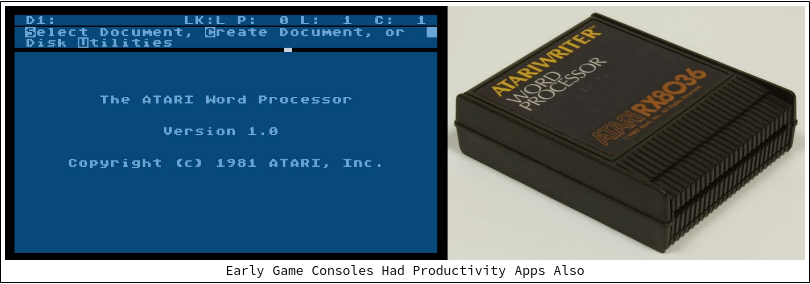
These platforms were of course sometimes useful, and exposed people to the potential of general purpose computing. However, if productivity was your #1 use case, you would have been better off with an Apple II, which was more dedicated to the task.
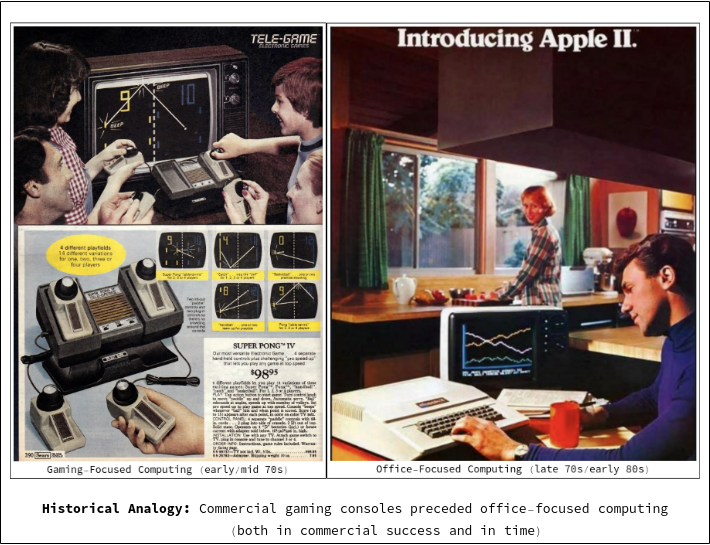
Similarly, we feel that if productivity is your #1 use case for a VR headset, you are better off getting one that is built from the ground up for that specific purpose.
